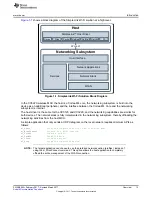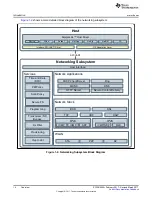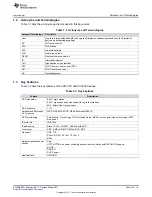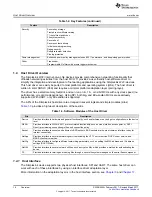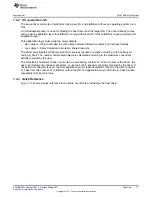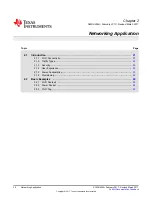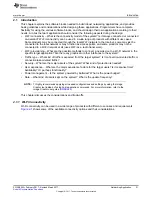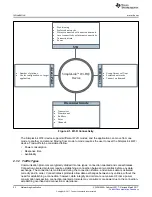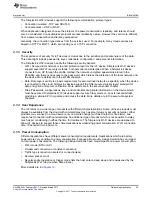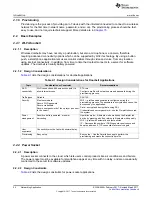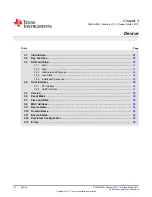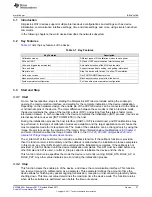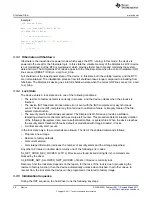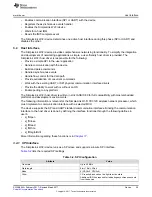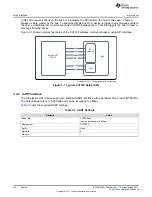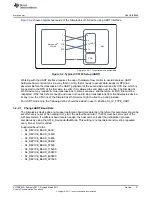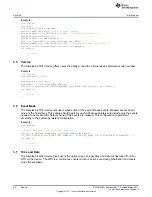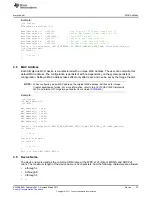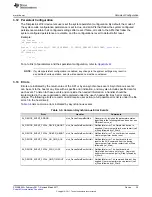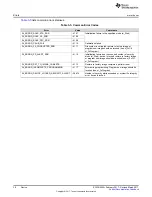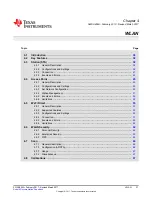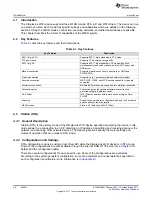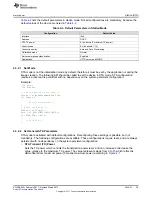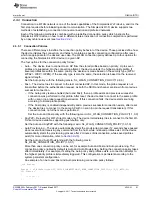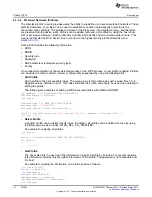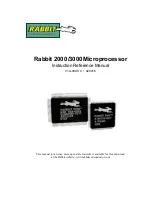
Introduction
27
SWRU455A – February 2017 – Revised March 2017
Copyright © 2017, Texas Instruments Incorporated
Device
3.1
Introduction
SimpleLink Wi-Fi devices support multiple internal-device configurations and settings such as device
initialization, communication interface settings, time and date settings, and more, using simple host-driver
commands.
In the following chapters, the word
device
describes the network subsystem.
3.2
Key Features
lists the key features of the device.
Table 3-1. Key Features
Key Features
Description
Calibration modes
Different types of RF calibration modes to save power
SPI and UART
SPI and UART communication interfaces support
Little- and big-endian auto-detect
Automatic detection of the MCU endian state
Time and date
Support time and date setting, and getting information
Stop time-out
Stop the device with time-out, to allow TX completion
Get device version
Get PHY\FW\NWP\Host versions
Mask asynchronous event
Mask asynchronous events from the device
System-persistent configuration
Set the entire system-persistent configuration
3.3
Start and Stop
3.3.1 Start
From a host perspective, steps to starting the SimpleLink Wi-Fi device include setting the enable pin,
opening the communication interface, and waiting for the complete indication of the device initialization.
Depending on the hardware design, the enable pin of the CC3120 device can be connected to the nReset
or nHibernate pins of the device. The major difference between these modes is that in hibernate mode,
the device maintains the value of the real-time clock (RTC), and exiting from this state is faster (more
information follows). In both modes when the device completes the initialization (INIT) process, it sends an
internal asynchronous event (INIT COMPLETE) to the host.
During the initialization process the host interface (UART or SPI) is determined, and RF calibrations may
be performed. A few types of calibration modes are available, and the target application must choose the
most compatible mode for its requirements. The mode of the calibration can be changed only by using the
Image Creator tool, during the creation of the image. More information about calibrations is in
,
and more information about the Image Creator tool is in the
CC3120, CC3220 SimpleLink Wi-Fi and
Internet of Things Image Creator User's Guide
.
The sl_Start API of the host driver can provide a callback function. If the callback function is provided,
then the function returns immediately, and the callback is called when the initialization process completes.
In this mode, any other APIs should not be called until the initialization completes. If the callback is not
provided, sl_Start is blocked until the device initialization completes. This API must be called before any
other SimpleLink API is used, or after sl_Stop is called to reinitialize the device and the driver.
This function return value specifies the mode the device is currently running: ROLE_STA, ROLE_AP, or
ROLE_P2P. Any other value indicates an error during the initialization process.
3.3.2 Stop
This function clears the enable pin of the device, and closes the communication interface. This function
can receive time-out (in milliseconds) as a parameter. This parameter defines the amount of time the
device allows for finishing any packet ongoing transmission, reception, or disconnection gracefully before
shutting down. This time-out value determines the maximum time the device waits. The function returns
when all the activities are performed even before the time-out expires.

